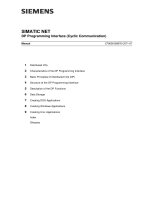Serial communication
Bạn đang xem bản rút gọn của tài liệu. Xem và tải ngay bản đầy đủ của tài liệu tại đây (988.22 KB, 51 trang )
Chuyên đề II
Vi điều khiển và ứng dụng
Serial Communication
Truyền thông nối tiếp
2 the Universal Asynchronous Receiver
and Transmitters (UARTs)
2 the SPI synchronous serial interfaces
2 the I 2 C synchronous serial interfaces
2
Synchronous serial
3
Asynchronous Serial
Interfaces
4
Some comparisons
5
More
6
Synchronous
Communication Using the
SPI Modules
7
SPI applications
Interfacing with memory devices
Serial EEPROMs - e.g., 25xx256
Interfacing with codecs
Control Ports or PCM Data
Interfacing with communication chips
Bluetooth
Boot Loader
8
9
Giải thích các bit điều khiển
10
Bít điều khiển
11
SPI overview
Serial transmission and reception of 8-bit or
12
16-bit data
Full-duplex, synchronous communication
Compatible with Motorola’s SPI and SIOP
interfaces
3-wire interface
Supports 4 different clock formats and
serial clock speeds up to 10 Mbps
Buffered Transmission and Reception
SPI - Master / Slave
SPI module can be configured as Master or
Slave
In any SPI data transfer, there is a single
Master and a single Slave
Selected by MSTEN bit, SPIxCON<5>
Master generates serial clock pulse (on SCK
pin)
SCK frequency determined by Primary
Prescaler bits (PPRE) and Secondary
Prescaler (SPRE) bits in SPIxCON register
Fsck = Fcy / (PPRE * SPRE)
13
14
SPI - Serial Clock Formats
4 clock formats - set by CKP and CKE bits
in the SPIxCON register
SCK is low when module is idle, SDO
changes on clock going high (CKP=0, CKE=0)
SCK is low when module is idle, SDO changes
on clock going low (CKP=0, CKE=1)
SCK is high when module is idle, SDO
changes on clock going low (CKP=1, CKE=0)
SCK is high when module is idle, SDO
changes on clock going high (CKP=1, CKE=1)
15
Ví dụ
16
SPI - Transmission
Module is enabled by setting SPIEN bit in the SPIxSTAT register
Transmission begins when data is written into the Master’s
Transmit Buffer
SCK pulses are generated by the Master only when SPIxSR
contains data
Transmission can be disabled by setting the DISSDO bit in the
SPIxCON register
SPIxBUF is buffered
You can write SPIxBUF while data is being shifted out through
SPIxSR
SPITBF bit in the SPIxSTAT register indicates that the
Transmit Buffer is full
Wait until SPITBF = 0 to write data
Transmission of the new data starts as soon as SPIxSR is idle
17
SPI - Reception
Reception occurs concurrently with the transmission
When all bits of data have been shifted in through
SPIxSR, SPIxSR contents are transferred to Receive Buffer
SPI interrupt (indicated by SPIIF bit and enabled by SPIIE
bit) is generated so that buffer can be read
SPIxBUF subject to Receive Overflow
SPIRBF bit in the SPIxSTAT register = 1 indicates that the
Receive Buffer is full
SPIxBUF must be read before new data is completely
shifted in
When receive overflow occurs...
New data not transferred to Receive Buffer
SPIROV bit in SPIxSTAT is set
18
Configuration
19
SPI - Data Sizes
8-bit and 16-bit data communication
SPI operation is identical for both data
sizes, except number of bits transmitted
For 8-bit data, Master generates 8 SCK
pulses
For 16-bit data, Master generates 16 SCK
pulses
16-bit operation is selected by setting the
MODE16 bit in the SPIxCON register
20
SPI - Framed SPI
SPI supports Frame Synchronization
Enabled by setting FRMEN bit in the SPIxCON
register
SCK pulses are continuous in this mode
21
SPI - Framed SPI
Frame Master generates Frame Sync pulses
Frame Master or Slave mode is selected by
clearing or setting the SPIFSD bit in the
SPIxCON register
Shifting of data starts only after a Frame
Sync pulse is generated on the SS pin
4 possible Framed SPI modes
SPI Master, Frame Master
SPI Master, Frame Slave
SPI Slave, Frame Master
SPI Slave, Frame Slave
22
SPI - chức năng phụ
Slave Select (SS) pin functionality
In this mode, the Slave functions only as
long as the SS pin is driven low
Enabled by setting SSEN bit in the SPIxCON
register
Slave Wake-up from SLEEP
Since SCK pulses are provided by the Master,
SPI Slave can function in SLEEP
Slave Reception wakes up the device from
SLEEP
23
Ví dụ ghép nối với Serial
EEROM 25L256
// 1. init the SPI peripheral
#define SPI_CONF 0 x 8120 // SPI on, 8-bit master, CKE=1,CKP=0
TCSEE = 0; // make SSEE pin output
CSEE = 1; // de-select the EEPROM
SPI2CON = SPI_CONF; // select mode and enable
// send one byte of data and receive one back at the same time
int writeSPI2( int i)
{
SPI2BUF = i; // write to buffer for TX
while( !SPI2STATbits.SPIRBF); // wait for transfer complete
return SPI2BUF; // read the received value
}//writeSPI2
24
Đọc
Serial
ROM
// 25LC256 Serial EEPROM commands
#define SEE_WRSR 1 // write status register
#define SEE_WRITE 2 // write command
#define SEE_READ 3 // read command
#define SEE_WDI 4 // write disable
#define SEE_STAT 5 // read status register
#define SEE_WEN 6 // write enable
25









